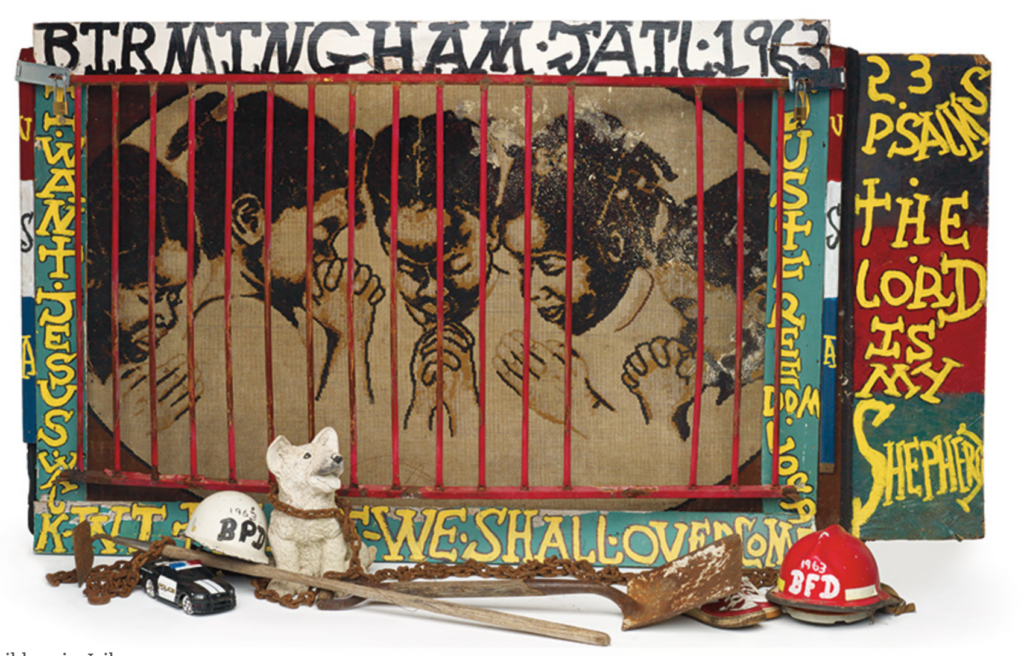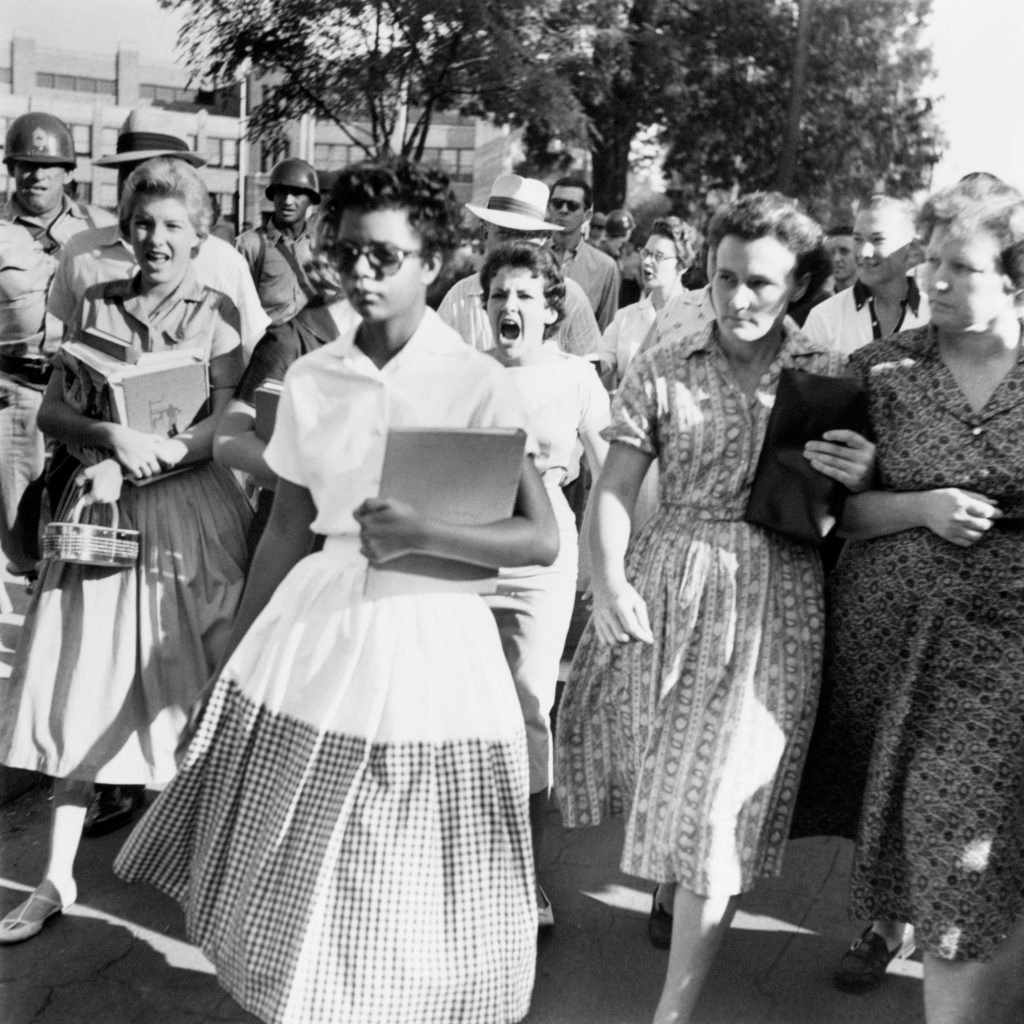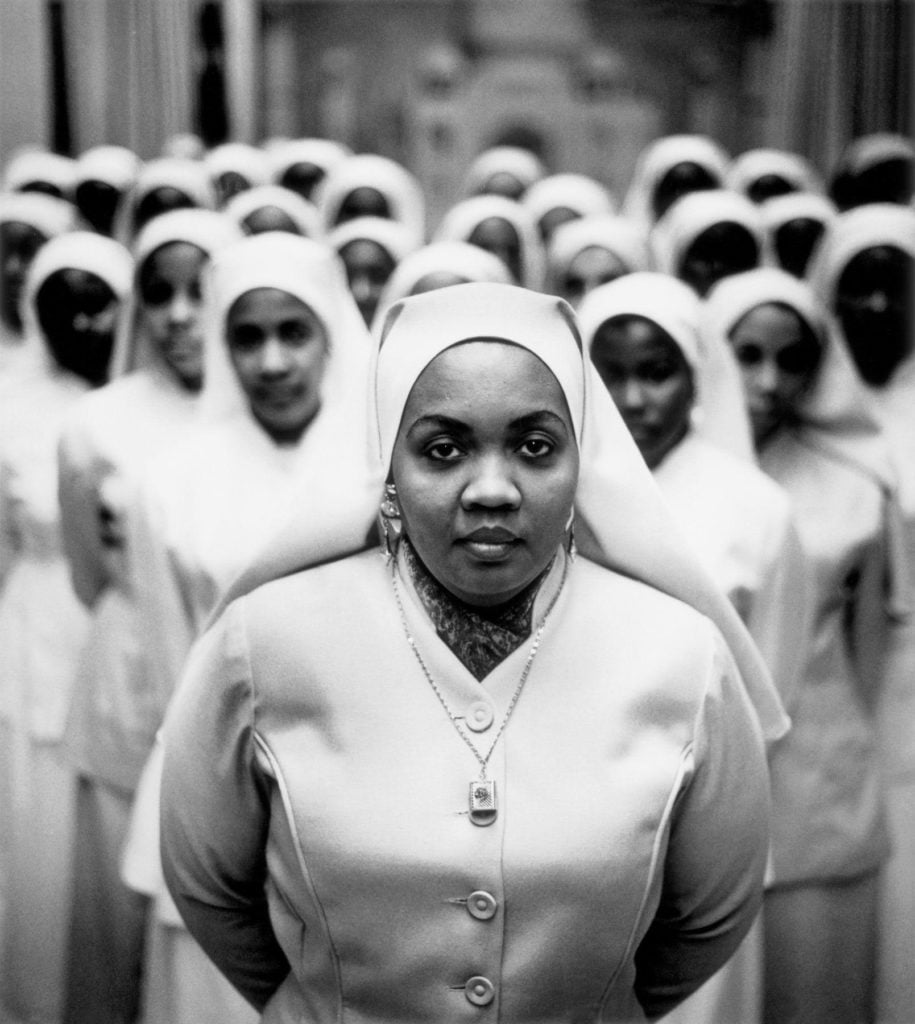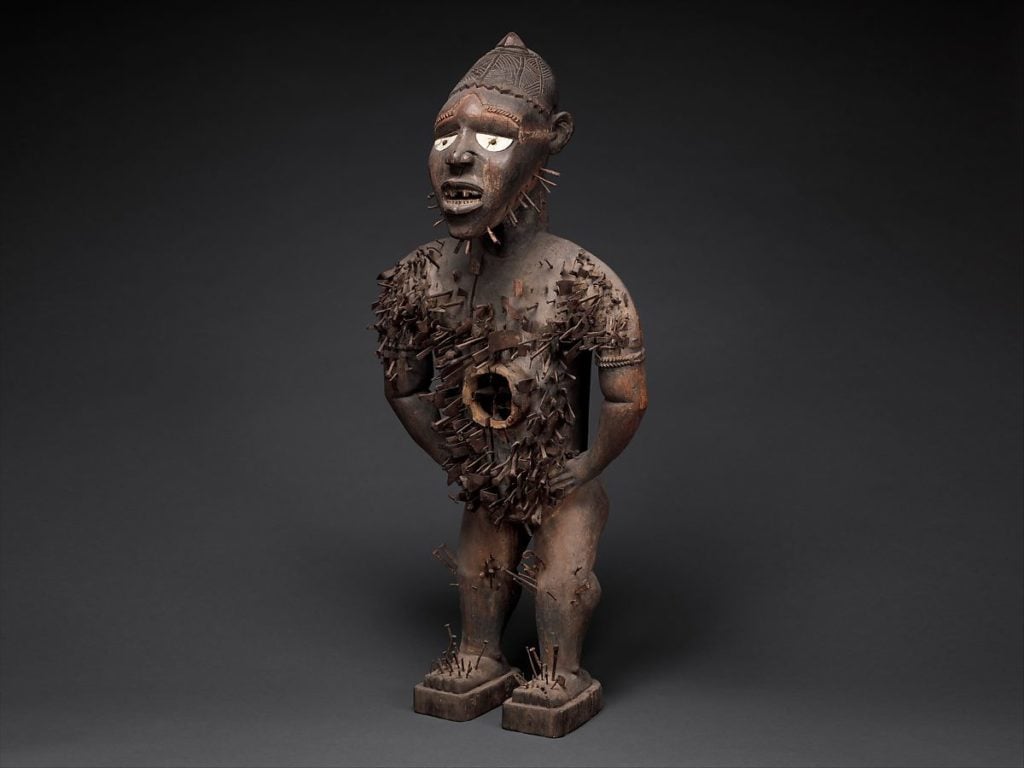Ceramic Art With Martin Luther King Jr Pictures the High
In award of Martin Luther King Jr. Day, we tasked curators across the state with the difficult task of choosing a unmarried work of art that they feel defines the ethos of the Civil Rights Era. Their choices present a kaleidoscopic and occasionally surprising group of works that span continents and centuries—from iconic photographs to ritual sculptural objects.
See the works and read the curators' insights below.
Joe Minter'southwardChildren In Jail (2013)

Joe Minter, Children In Jail (2013). Courtesy of Souls Grown Deep.
This contemporary piece of work by Joe Minter reflects back on Birmingham, Alabama'south Children's Crusade: On May 2, 1963, more than than i,000 students skipped school and took to the streets from the doors of the 16th Street Baptist Church, and for days faced police violence and dog attacks, brutal sprays of fire hoses, and mass arrests. Ultimately, more than 3,000 children took role in the direct actions. More than 500 children were jailed by Alabama Public Safety Commissioner Bull Connor, including 75 kids crammed into a prison cell meant for viii adults, and still others locked into animal pens at the fairgrounds for days on end. Cheers to their sacrifices and the widespread media images of brutalized blackness children, President Kennedy took notice, the city negotiated with Martin Luther Male monarch Jr., jailed demonstrators were freed, and Connor lost his task.
In Minter's multi-part sculpture, a seemingly domestic prototype of praying children is placed behind bright cherry-red bars. The violence of Birmingham's police and burn down departments is indicated by the strewn hats and smiling dog statue, laced with rusted chains aslope tools that Minter uses to refer to 400 years of labor and oppression inflected on Blacks by whites. A makeshift cage traps three baby dolls, representing kids in cages who fought "JUST TO B Free."
I'm however struck by my memory of this work, 5 years after seeing it at the Montgomery Museum of Fine Arts in Alabama. And, as a side note, I'll add that every person living in the US should visit Montgomery's Legacy Museum and National Memorial for Peace and Justice, the Equal Justice Initiative's racial injustice museum and elegiac monument to more than 4,400 lynching victims—African American men, women, and children.
—Carmen Hermo, acquaintance curator, Brooklyn Museum
Volition Count'sElizabeth Eckford of The Fiddling Stone Nine (1954)

Will Count, Elizabeth Eckford of The Footling Rock 9 (1954). Courtesy of Getty Images.
It can exist argued that there is no more important medium to the Civil Rights movement than that of photography. The documentation of violences enacted upon black people in the s—in private tiffin counters, in public parks and bridges, in educational spaces, so along—and the subsequent mass dissemination of this imagery, heightened public awareness of such abuses and galvanized a public's increasing demand for judicial and legislative action that would enforce the equality of African Americans. Indeed it said that the mass reproduction of Charles Moore'due south infamous photograph of Civil Rights protesters being high-pressure water hosed at a leap 1963 activity directly impacted the passage of the Civil Rights Act in 1964.
Yet as scholars and curators like Leigh Raiford, Maurice Berger, and Connie Choi take written, the usage, status, and office of photography during the movement was much more than complicated than mere documentary realism. For example, there was not uniformity around how these images were read and understood past all publics, even intra-racially; nor did all images themselves evince the larger context in which these actions took place or offer up the full scope of the movement's participants. Indeed, as Raiford argues, black people increasingly turned to photography as a tool for shaping and presenting their own images to themselves, non just an imagined white public.
Of course, photography in this moment also calls forth questions of spectacle, and that of the ethics surrounding the circulation of images that feature violence existence enacted upon, or violated, black persons. When has an image served its "purpose"? How practise the reproduction of these images serve to shape public consciousness over time in ways more complex than mere "sensation"?
In this image, a group of young white women and men are angry. This is gleaned from the facts of the faces: of the menacing glares, of the mouth agape in rage. A slight step ahead of them is the target of this terror: a young black adult female, looking forward through her sunglasses, clutching her binder in mitt.
There are the things that a photograph tin and cannot say. For instance, it had always been the plan for the group of students chosen to integrate Fiddling Stone Central High Schoolhouse in the autumn of 1957 to arrive together. I of the "Petty Rock Nine," xv-year-one-time Elizabeth Eckford had ultimately arrived at the wrong meeting place, not having received give-and-take of a shifted meeting plan. In this photograph, she makes her way through a mob of hundreds, with her gaze directed forward through her sunglasses, as she clutches her binder in hand, alone. This mob—which includes Hazel Bryan, who shouts aspersions at her back, and the National Guard deployed to terrorize the integrating students—prevents her from inbound school on this day. It would take the deployment of troops at the control of the president to let safe (physical) entrance for Eckford and the other eight, some weeks later.The traumatic events of this 24-hour interval will keep to consequence Eckford into her adulthood.
When I see this photograph, I retrieve of the ordinary and the extraordinary, of youth and of bravery. How a immature, ordinary girl, was forced to occupy a posture of extraordinary bravery in the face of a violence that was extraordinarily hostile and in part extraordinary in its ordinariness. I sit with what that means.
—Ashley James, acquaintance curator of contemporary art, Solomon R. Guggenheim Museum
Elizabeth Catlett'southwardHomage To My Young Blackness Sisters (1968)

Elizabeth Catlett, Homage To My Young Black Sisters (1968)
Homage to My Young Black Sisters represents the influence of hundreds of everyday young women who participated in grassroots organizing and revolutionary activity during the Civil Rights era. Catlett often identified with these women considering she, too, was consistently beleaguered past the US authorities for her revolutionary political ties and eventually forced to relinquish her American citizenship, in 1962. The gesture of the sculpture is clear. Its clenched fist and dominant stance shouts Black Ability in the wake of Jim Crow segregation. Catlett speaks openly to her audition with this piece of work, revealing that the pulse of the Civil Rights era began with black women.
—Kelli Morgan, associate curator of American art, Indianapolis Museum of Fine art at Newfields
Gordon Parks'southwardEthel Sharrieff, Chicago, Illinois (1963)

Gordon Parks, Ethel Sharrieff, Chicago, Illinois (1963).
No other visual medium defined the Civil Rights movement than documentary photography, particularly the black-and-white images of male leaders, cordons of marchers under turbulent skies, or black children in their Sunday best blasted with G-forces by the Birmingham fire department. Gordon Parks, one of the great chroniclers of the era, made the important decision to equally document blackness people in their communities, often in moments of peace and self-sufficiency. His "Black Muslims" series forLifemagazine was a wake-up telephone call for many non-black Americans who were fascinated and alarmed by the group. Park's portraitEthel Sharieff for the magazine feature stands as an iconic image of the series and the Ceremonious Rights era. A single woman set up against an army of sisters encapsulates all the resolve, communitarianism, and new consciousness the moment was brewing, without falling back on whatsoever proscribed clichés.
—Naomi Beckwith, senior curator, Museum of Contemporary Art, Chicago
Frank Bowling'southDark Journey (1969–70)

Frank Bowling, Night Journeying (1969–70). Courtesy of the Metropolitan Museum of Art.
It'south a alpine—even incommunicable—task to summarize the Civil Rights Era with a unmarried piece of work of fine art. The all-time I tin do is to highlight a few of my favorites (across media) and acknowledge to a particular favorite in the Met collection. I love and then many of Gordon Parks'due south photographs from the menstruum, especially Department Store, Mobile, Alabama (1956), an prototype that never loses its ability. Elizabeth Catlett'southward Black Unity (1968) is a neat sculptural icon of the period. David Hammons's body prints, such as The Door (Admissions Part) (1969), are difficult to surpass in their inventiveness and visceral impact. A favorite of mine at the Met is Frank Bowling's Dark Journey (1969-70), a beautiful painting in the artist'due south "Map" series. Bowling masterfully employs his staining and pouring techniques to ruminate on the forced ocean journeys endured by enslaved people taken from West Africa to the Americas and West Indies.
—Randall Griffey, curator, the Metropolitan Museum of Art
David Hammons'sThe Door (Admissions Office) (1969)

David Hammons,The Door (Admissions Function) (1969). Courtesy of Collection of Friends, the Foundation of the California African American Museum, Los Angeles.
With the ridges of fingerprints and curls of hair nevertheless visible in the dried black oil, a human Rorschach test is printed upon a transparent windowed admissions door. Manus-prints halo above the prototype of a double confront; the gesture is i, often futile, fabricated in pleas for safety, one which remains of import in protests of communal recognition. David Hammons's The Door (Admissions Part) (1969) not simply critically comments on the blockades of academia, civil rights, and nationhood, but speaks directly to the political commitments and legacy activism of youth in the state.
This work continues to reaffirm the presence of barricades and borders that remain closed but could be hands opened, if merely for the unmarried plow of a wrist. This piece of work, often generously loaned past the California African American Museum, continues to exist emblematic of artistic interventions of the Civil Rights era and has been a role of significant exhibitions such as "Crosscurrents: Africa and Black Diasporas in Dialogue, 1960-1980" at the Museum of the African Diaspora, San Francisco; "Witness: Fine art and Civil Rights in the Sixties" at the Brooklyn Museum, and is now on view every bit a part of the international tour of "Soul of a Nation."
—Emily A. Kuhlmann, director of exhibitions and curatorial affairs, Museum of the African Diaspora
Congolese's Nkisi Nkondi (Ability Effigy)

Nkisi Nkondi, 19th century, Republic of Congo, Republic of angola, Chiloango River region. Woods, plant fiber, iron, resin, ceramics, material, pigment. Yombe creative person. Courtesy of the Metropolitan Museum of Art.
Often referred to as a ability figure, nkisi was a container that held the bilongo (medicine) that purified the self and community in "Kongo" culture. This effigy mediated the sacred and profane spheres, addressing social concerns and warding off evil spirits. It's jarring presence endured many driven nails that bind promises and seal deals. No other symbol could have encapsulated the Civil Rights movement in this state. Despite all the tribulations, progress was made in archiving some of the aspirations that defined the cause at that time.
—Ndubuisi C. Ezeluomba, Françoise Billion Richardson curator of African art, New Orleans Museum of Art
Follow Artnet News on Facebook:
Desire to stay ahead of the fine art world? Subscribe to our newsletter to go the breaking news, eye-opening interviews, and incisive critical takes that bulldoze the conversation forward.
Source: https://news.artnet.com/art-world/artworks-that-define-the-civil-rights-era-1755375